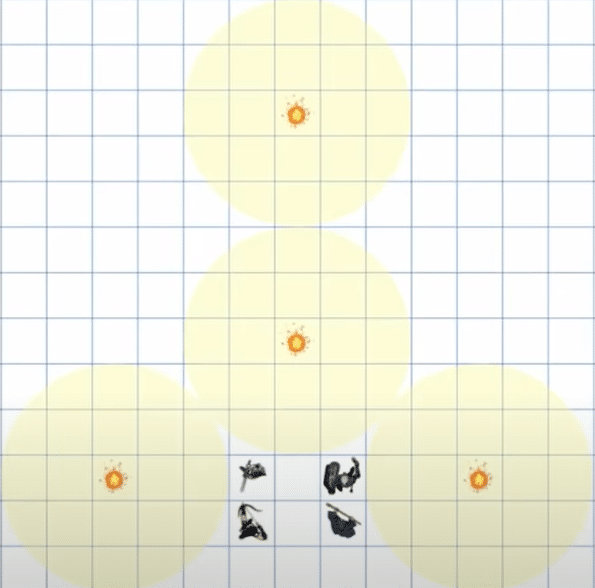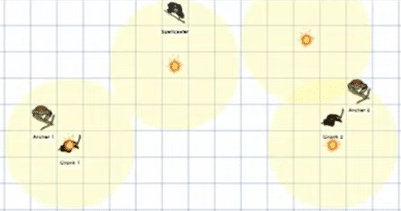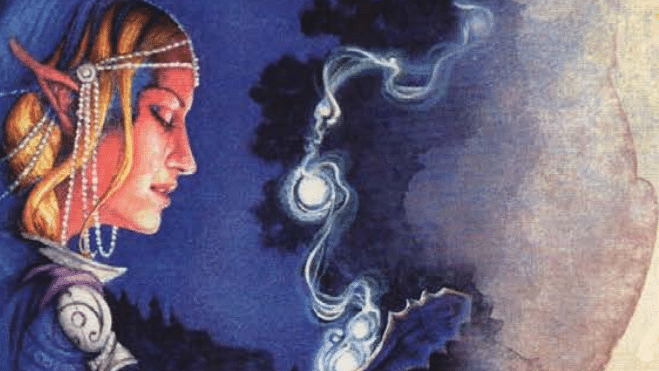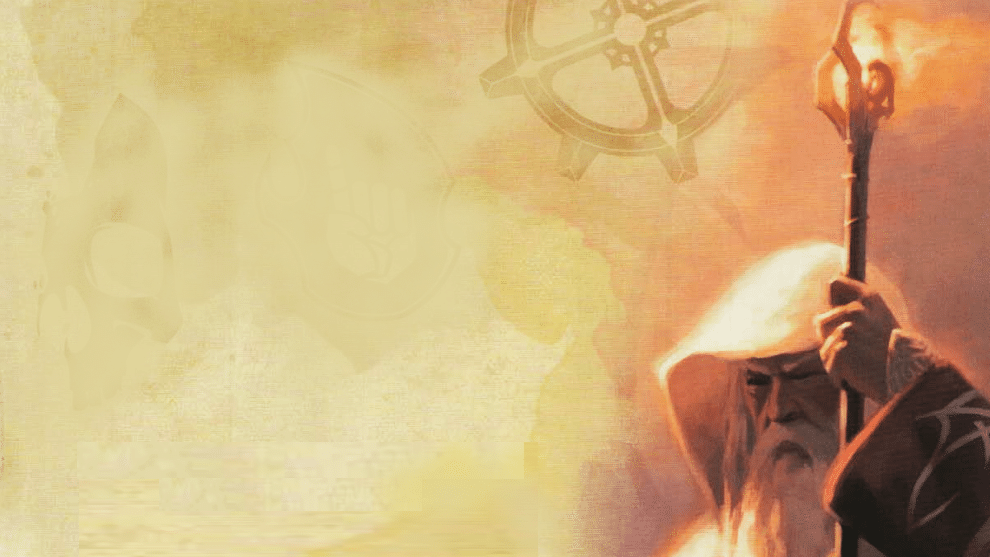You create up to four torch-sized lights within range, making them appear as torches, lanterns, or glowing orbs that hover in the air for the duration. You can also combine the four lights into one glowing vaguely humanoid form of Medium size. Whichever form you choose, each light sheds dim light in a 10-foot radius.
As a bonus action on your turn, you can move the lights up to 60 feet to a new spot within range. A light must be within 20 feet of another light created by this spell, and a light winks out if it exceeds the spell’s range.
Casting Time: 1 action
Range: 120 feet
Components: V, S, M (a bit of phosphorus or wychwood, or a glowworm)
Duration: Concentration, up to 1 minute
School: Evocation cantrip
Who can cast Dancing Lights? Bards, Sorcerers, Wizards, and Artificers have Dancing Lights on their class spell lists. Drow can also cast Dancing Lights at will.
Dancing Lights 5e
Dancing Lights is a solid utility cantrip in DnD 5e, with a few good uses. I’ll cover a few of the ways I’ve seen it used in my games, as well as answer some popular questions about the spell’s rules.
How Does Dancing Lights Work in 5e?
Dancing Lights creates four small light sources within 120 feet of the caster. Each light must be within 20 feet of another light, or else it instantly disappears.
Each light sheds dim light in a 10-foot radius. For example, here’s what Dancing Lights could look like on a map:

Or like this:

If you wish, you can also make one Medium size, vaguely humanoid form using all four lights (it still only sheds dim light in a 10-foot radius).
As a bonus action, you can move the lights up to 60 feet (still within 120 feet of the caster, and still within 20 feet of at least one other light).
How to Use Dancing Lights in 5e
Here are a few ways to use Dancing Lights in DnD 5e:
-
Light enemies while you’re in darkness. If your party is in total darkness, but the enemy is lit up by Dancing Lights, you’ll get to attack with advantage, while your enemies will have to guess your location AND attack with disadvantage (Unseen Attackers and Targets, PHB 194-5).
Needless to say, this is a huge swing in power for your party’s ranged attackers and spellcasters. BUT most creatures who spend their time in total darkness have Darkvision, meaning they’ll still be able to see you in total darkness (although with disadvantage on Perception checks, making stealthing and hiding easier).
Of course, if someone in your party doesn’t have Darkvision, then they won’t be able to see where they’re going while walking in total darkness…but they will be able to see the dimly lit area created by Dancing Lights.
-
Long-range communication. With four lights, you can create several shapes and designs. If you assign meaning to these symbols beforehand, then you can communicate with your party or friendly NPCs from a long distance.
For example, a diamond could mean “trouble, come help,” while a triangle might stand for “wait where you are.” You can even get fancy with moving lights, disappearing lights (by moving out of range of other ones) having a different meaning than static lights.
Incidentally, there’s an in-game creature that does this already: Deep Rothe. They use Dancing Lights to communicate, and if a creature with an intelligence score of 2 can figure it out, I’m sure your party can, too. 🙂
-
Look underwater. Deep, dark pools of water can be scary and/or enticing. Is there a deadly Aboleth down there, or possibly a hoard of treasure? One way to scope things out from a (relatively) safe distance is to send your Dancing Lights down into the deep.
You have much greater control of how they move than you would by tossing a rock with the Light spell on it into the water. Plus, those vibrations might attract unwanted attention, like Boromir tossing disturbing the Watcher in the Water in The Fellowship of the Ring (the book; I know it was Pip in the movies).
-
Investigate a cavern. By sending lights into a steep drop-off, you can see exactly what’s hiding down there. Again, this is superior to dropping a Light cantrip’d pebble down there, since you can have the light hover in place in areas of interest, rather than get a quick glance as gravity does its thing.
-
Create a distraction. Whether you make the lights look like torches, lanterns, or glowing orbs, any source of light without a creature holding it is instantly suspicious. If you’re trying to draw the attention of guards or something, sending lights past their field of vision might accomplish that.
Heck, glowing orbs also look like will-o’-wisps, a rather scary creature for most — you might even scare them away from their post, or cause them to go looking for backup. Or the “vaguely humanoid form” could be used to scare someone who might mistake it for a banshee, ghost, or some other ethereal creature.
Be careful, though; savvy Underdark dwellers are well aware of the Dancing Lights spell, and you might actually end up giving away your location rather than scaring anyone or creating a distraction.
-
Trigger/bait an ambush. Similar to the above tip — send in your Dancing Lights to an area that you think might be watched by would-be ambushers, in hopes that they fire a shot at them and give away their location. No surprise round for them, and POSSIBLY a surprise round for you! Or, at least one attack with advantage as an unseen attacker.
With the “vaguely humanoid” option, this is even more likely to work.
-
Pair with illusion magic. A couple good options here:
-
Add sound with Minor Illusion, like a banshee’s wail or something, along with the humanoid form to help sell the whole thing.
-
Add an actual humanoid-looking creature with Silent Image who is holding a “lantern” (a single Dancing Light).
-
Make an illusory version of a creature that normally emits light, paired with Dancing Lights to make the illusion more convincing.
-
-
Boost Performance checks. Either with a light show of multiple lights, or a humanoid form backup dancer.
What Are the Rules for Dancing Lights in 5e?
The rules for Dancing Lights in DnD 5e are as follows:
-
You don’t need to see your targeted area to cast Dancing Lights. A spell will tell you if you need to see your target; Dancing Lights doesn’t, so you don’t. This means you can cast Dancing Lights while you’re “blinded” by total darkness. However, you still need a clear path to your target, as a general rule for all spellcasting in 5e (PHB 204).
-
You still have disadvantage on Perception checks in dim light. Because it counts as a “lightly obscured area” (PHB 183). However, if you have Darkvision, you can see in dim light as though it were bright light.
-
A light can never be more than 120 feet from you. “A light winks out if it exceeds the spell’s range,” which is 120 feet. This breaks the general rule of spells that “once a spell is cast, its effects aren’t limited by its range, unless the spell’s description says otherwise” — Dancing Lights does say otherwise (PHB 203).
Is Dancing Lights a Good Spell?
Yes, Dancing Lights is a good utility spell. Having access to long-range light sources is great for scouting, getting the upper hand in a fight in dark environments, communicating, and plenty of other creative uses.
But the real question for most players is whether they should get Dancing Lights or the Light cantrip…
Dancing Lights Compared to Light
Let’s break down the differences between these two illuminating cantrips:
-
Light causes one object to shed bright light in a 20-foot radius and dim light for an additional 20 feet for one hour.
-
Dancing Lights creates four light sources that shed dim light a 10-foot radius.
-
Light lasts for one hour hour, with no concentration requirement
-
Dancing Lights lasts for one minute, with a concentration requirement.
Basically, Light means your party always has a torch, and with no hassle of worrying about concentration. It also provides a greater brightness and radius of light from a single source.
Dancing Lights is a short-term source of light that’s tricky to use in combat, because you have to worry about concentration. It also provides less bright light, but an equivalent total radius of light. However, those light radiuses can be shaped in a more flexible way to light different areas.
In my opinion, Light is the more reliable option if you want a constant light source, whereas Dancing Lights is a more dynamic, stealthy light source for short-term benefits.
Both have a ton of creative applications. But if you’re just looking for a magical torch at all times, Light is your better choice. If you’re looking for more shenanigans, Dancing Lights is the cantrip for you.


![Speak With Animals 5e [5 Ways To Use The DnD Spell, DM Tips, Rules] dnd-5e-leucrotta](https://www.dndlounge.com/wp-content/uploads/2022/03/dnd-5e-leucrotta-300x157.jpg)
![Spider Climb 5e [8 Ways To Use The DnD Spell, DM Tips, Rules] misty-step-5e](https://www.dndlounge.com/wp-content/uploads/2022/03/misty-step-5e-300x161.jpg)
![Daylight 5e [6 Ways To Use The DnD Spell, DM Tips, Rules] dnd-5e-tree-mushrooms](https://www.dndlounge.com/wp-content/uploads/2022/03/dnd-5e-tree-mushrooms-300x300.jpg)
![Leomund's Tiny Hut 5e [7 Ways To Use The DnD Spell, DM Tips, Rules] dnd-5e-party-in-forest](https://www.dndlounge.com/wp-content/uploads/2022/03/dnd-5e-party-in-forest-300x157.jpg)